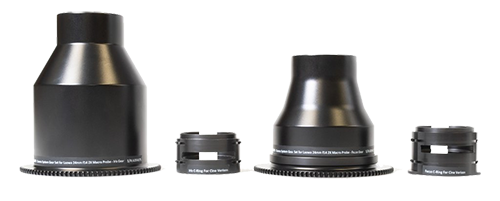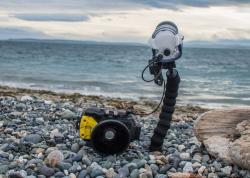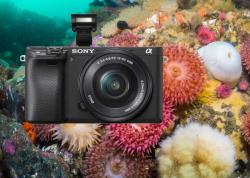Laowa 24mm f/14 2X Macro Probe Review
The Laowa 24mm f/14 2X Macro Probe, aka “Bug Eye” lens, made by Venus Optics, might as well be the world’s coolest lens. It reeks of modern innovation – from a crowdfunded origin to a 2:1 macro-wide-angle-hybrid capability. This lens offers a viewpoint so unique it can’t be seen with the human eye and truly brings you down to the perspective of the tiny creatures that inhabit this planet.
If you’ve ever wondered what it’s like to look through the eye(spot) of a nudibranch, hermit crab, or anemonefish, this lens does exactly that. By using a Nauticam housing, you can actually take this lens to diving depths underwater.
Because this lens is so weird, it requires a bit of an explanation before we delve into its specifications. At its core, the Laowa 24mm is a macro lens. A macro lens……with a 40 cm barrel and 27 lens elements! In fact the Laowa 24mm is a 2:1 macro lens – a true super macro lens rather than the traditional 1:1 macro. That means it can reproduce objects at twice life-size.
However, the Laowa lens is also a wide-angle lens in many ways as it offers an 84 degree field of view. Although this isn't ultra-wide angle compared to a fisheye, the LAOWA 24mm can still capture a nice background in a macro image, creating a “bug eye” affect. Such a unique wide-angle macro perspective is sought after by many underwater photographers, but there are few options available to create it.
We have been very pleased with the results after taking this lens diving in the cold waters of North Pacific. It is indeed as tricky to use as it looks, but it can be really useful for specific applications. After our underwater tests, we found the lens is fairly similar to an underwater macro lens with additional functionality and a unique perspective.
Although the lens appeals to a limited market, it certainly has the potential to change underwater imagery and video. For the first time ever, there is a lens that can capture anything from wide angle kelp and jelly shots to supermacro footage of crawling seastar tubefeet! In just one dive we were able to capture some of the most iconic of the North Pacific's creatures as you can see below...
![]()
Bluewater Photo Laowa 24mm f/14 macro probe options:
Laowa 24mm f/14 2x macro probe
Nauticam N120 Port Adaptor for Laowa 24mm f/14 2x macro probe
Laowa 24mm macro lens specifications
• 24 mm focal length (f/14 max aperture)
• 2:1 macro photography - & infinity focus capability
• 27 lens elements (19 groups)
• 7 aperture blades
• 470mm minimum focusing distance
• Manual focus
• Multiple mounts – Canon EF, Nikon F, Sony FE, Pentax K. Cinema mounts: Arri PL/Canon EF
• Wide-angle macro “Bug-Eye” perspective – 84 degree field of view
• LED ring light embedded into lens tip
• Maximizes depth of field (f/14 speed lens)
• Compatible with both a 35mm full frame and Super35 image sensor
• Designed for both video and still photography
• Front of lens barrel is waterproof
• 40cm long lens barrel
• Weight: 474 grams (1.04 lb)
Lens Build
As you might imagine, the Laowa 24mm macro lens requires a very unique design to accomplish a very unique perspective. Laowa actually describes this lens as being a “probe,” and it very much is. The barrel of the lens is 40cm long and consists of a whopping 27 lens elements in 19 groups! That’s a lot of complex glass to produce an amazing perspective. The front of the barrel is waterproof which is excellent for top-side aquatic applications but you still need a housing while diving.
The lens was developed to fit with 35mm full frame sensors and Super35 video sensors, but it can be adapted for many cameras and mounts via mount adapters. The standard mounts that work with it include the Canon EF, Nikon F, Sony FE, Pentax K, and Arri PL. That’s right – it’s compatible with cinema cameras! There are adapters available for Fuji X and micro four thirds mounts.
One of the coolest features of this lens is the LED ring light at the front of the lens that can be used to illuminate very hard to reach places – a true gem for professional macro photographers and videographers.
Ultimately, the lens is relatively light weight for the large barrel considering that it weighs just over a pound.
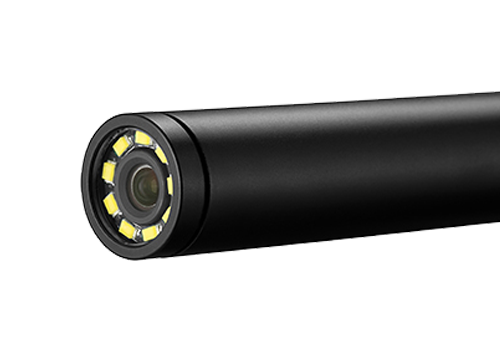
Lens Optics
The optics on this lens are as crazy as the build. Because the lens is a 2:1 macro lens, it has a maximum aperture of f/14. Although this might seem insanely small for a max aperture, it’s quite necessary. Anything larger would create too shallow of a depth of field for anything to be captured in detail. One of the most impressive aspects of this lens is that it can focus to infinity which makes it a much more versatile piece of equipment than we initially presumed. We were able to capture amazing wide angle video as well as super macro shots all in the same dive. No other lens can do this!
A “bug eye” perspective at 2:1 macro creates a viewpoint that can’t be seen by the human eye. Imagine being a tiny crab walking by a nudibranch and seeing ever ridge on its rhinophore. This lens can do that.
One issue we had with the optics was the fact that you lose a few stops of exposure by the nature of the length of the barrel. It's a dark lens. In many situations we had to shoot video with ISO's as high as 3200 - especially in darker water. In order to help capture as much of the shadow detail as possible we recommend shooting in a Log picture profile if possible.
LAOWA 24mm Macro for Underwater Photography
The implications of this lens for underwater photography – especially macro - is huge. As we’ve mentioned, the bug eye perspective is a unique view that is bound to be coveted by any macro photographer. It is different from other macro lenses by the fact that you can get a fair amount of background in a very close up macro shot. For supermacro especially, you can capture a lot more context in an image.
However, the LAOWA lens is more difficult than a normal macro lens to capture photos given complications arrising from the long barrel and 2:1 capability. It can sometimes take more patience and stability than a macro lens to use due to the awkward shape. In some cases it is easier to use because the wide field of view helps keep the subject in the frame. We found that although it is great for getting into nooks and crannies, it can sometimes be difficult to properly light photos due to the long barrel. Perhaps the biggest difficulty of the lens is the fact that the long barrel and 2:1 macro results in the loss of a few stops of exposure. The flat port of the lens also causes a little softness around the edges of the lens. It's also important to note that this lens can only be manually focused and the aperture is only adjusted manually. However, all of these issues have remedies underwater. We've provided some tips to help you shoot great photos with the LAOWA lens.
Tips for Underwater Photography
After diving with the LAOWA 24mm macro lens, we've come up with a few tips to help you maximize the benefits from this lens:
1. Keep in mind the lens is a manual focus lens. Try to focus on a similar plane to your anticipated subject before you shoot with the lens. Otherwise, you'll spend all your time hunting for focus and you'll miss the shot.
2. The corners on this lens can be a little soft during still photography. We recommend closing your aperture (increase f-stop) for more depth of field. Keep in mind that you'll lose some exposure on an already dark lens. Although you're shooting with a small aperture, try not to get a black backgrond or the photo will have the same perspective as any other macro lens.
3. Bump up your ISO. Although you'll get more noise in your photos, this lens is a dark lens due to the large barrel and 2:1 macro.
4. Use long strobe arms. It's difficult to light your subjects with such a long barrel. A long strobe arm helps your artificial light reach what you're shooting. In this case it can help to directly point the light source at the subject - dial it down to reduce backscatter.
5. Shoot up and try to get some kind of background structure in your image. The more negative space you have in the image, the more it looks like a normal macro photo.
6. Shoot a full frame camera. Although there are adapters for this lens and other-than-full-frame cameras, we don't recommend it. The lens was designed for full-frame cameras and if you use a cropped sensor than you lose the unique field of view that comes with this lens.
7. Use a mirrorless camera or external monitor so you can see if your image is in focus. Use focus peaking, if your camera has it, so that you can see where the focus is.
LAOWA 24mm Macro for Underwater Video
The Laowa 24 mm macro probe is optimized for video, which is an exciting and somewhat rare attribute when it comes to lenses. In fact, we felt that underwater videographers will reap the most benefits from this lens. It's smooth, sharp, and produces gorgeous results - that is, if you can handle the manual focus and 2:1 macro. The lens is compatible with two cinema mounts – the Arri PL and the Canon EF mounts.
The reason the LAOWA lens is so good for macro video with the field of view. The wide angle view helps stabilize macro video and put the subjects in the context of an environment rather than just standing alone. Although many of our shots looks like they were taken with an ordinary macro lens, if you look closely you'll notice that you can see a lot more of the environment. Perhaps the most exciting feature of this lens for underwater video is that it can focus to infinity. This means that you can take both true wide angle video and true macro video with this lens. Although we don't recommend the lens for wide angle photos, in a pinch it did a great job at shooting wide angle video - especially when we used Log profiles to counteract the loss of exposure from the long barrel.
With video, as well, the LAOWA 24mm macro has it's set of challenges. 2:1 macro (supermacro) is extremely cool, and the video is extremely crisp, but it's very difficult to keep stable. Because the lens is a manual focus lens, turn your focus dial can sometimes move your video and affect stability. Sometimes you have to trade off between getting the proper focus and taking stable video. As with photography, the long barrel, small aperture and extreme macro make it a very dark lens with a significant loss of exposure. Not to fear! We have a number of tips for creating the best underwater video possible with the LAOWA 24mm f/14 macro.
Tips for Underwater Video
Taking underwater video with the LAOWA 24mm macro was an absolute joy. Here are some the best tips we came up with for maximizing the unique nature of this lens:
1. Shoot with a Log picture profile or RAW video (if you can). The long barrel, small aperture, and macro perspective result in a loss of exposure. The best way to retain details from your shadows is shoot in a Log profile or RAW video, if you can.
2. Shoot full frame video with no crop factor. If you shoot on a crop sensor camera or video with a crop factor than you lose the unique field of view that is wide-angle macro.
3. Find the right focal plane for your subject and keep your lens there. If you mess too much with manual focus, it's easy to miss the action. Try to pan in and out before trying to manually focus the lens. The manual focus dial can decrease the stability of your video.
4. Shoot at 120fps (frames per second) to slow down your video for increased stability in post production.
5. Make use of the full range of this lenses capability. If you see a good wide angle subject go for it! If you see a good macro subject, go for it! It worked for us. We got great macro and wide video on the same dive.
6. Look for unique subjects in nooks and crannies. We took some nice video of zoanthids that we found in a hole.
7. Use long arms for your video light in order to position it close to the front of the barrel for proper video lighting.
8. Use a tripod if possible for increased stability.
9. Take video at a completely open aperture or a stop or two from open. This is where the lens will perform the best. Because of the loss of exposure with this lens, we recommend trying to get as much light into this lens as possible.
10. Bump up your ISO. Again, because this lens is a dark lens, it can be beneficial to shoot at a high ISO. When we shot in dark North Pacific waters, we needed to shoot at ISO 3200 most of the time. Not ideal, but on a nice full-fram camera like the Sony a7R III or Sony a7R IV, it will do.
11. Use this lens in locations with high ambient light. This will let you shoot at lower ISOs for less noise as well as increase your depth of field and still get a pleasing background in the video.
12. Use a mirrorless camera or external monitor so you can see if your image is in focus. Use focus peaking, if your camera has it, so that you can see where the focus is.
The Best Cameras with the LAOWA 24mm Macro
Because of the specific nature and underwater applications of the LAOWA 24mm macro probe, we recommend using only a specific set of cameras underwater with the lens. Here is what you need from a camera to get the most out of the LAOWA lens:
1. Your camera should be mirrorless or have an external monitor. We highly recommend using a mirrorless camera so that you can maximize your live view of the lens on the LCD. Even with a magnified viewfinder underwater, it's fairly difficult to see your subject and make sure that it is in focus with this lens.
2. Your camera should have a manual focus peaking mode so that you can see where your manual focus is. This is almost essential as it can be very difficult to tell that your focus is accurate underwater when you are using manual focus.
3. You camera should have a full frame sensor for the widest field of view with this lens.
4. For video, there should be no crop factor.
5. Your camera should function well at high ISOs with as little noise as possible.
6. Your camera should offer LOG or HLG picture profiles. RAW output is even better.
Given these criteria our top camera choices for underwater use with the LAOWA lens are the Nikon Z7/Z6, Sony A7/A7S/A7R series, and Panasonic S series cameras.
Underwater Housing Compatibility
Although the lens is compatible with many cameras, with such an awkward design, there are very few underwater housings that are compatible. In fact, currently only one manufacture has designed a port system that can be used with the lens – Nauticam.
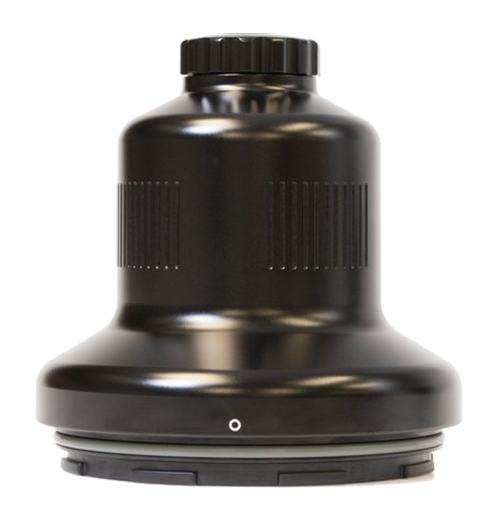
Nauticam N120 Port Adaptor for Laowa 24mm f/14 2x Macro Probe
The Nauticam N120 port adaptor is one of Nauticam’s most interesting ports for a very interesting lens. The Nauticam port adaptor leaves the original front lens element outside of the port opening since the front of the lens is waterproof. The port adapter can be used with either cinema housing for DSLR housings. The port also has two Focus/Iris control options – the standard and cine-mod versions. The Cine-mod version comes with de-clicked aperture adjustments as well as cinema-styled focus to allow for easy focus. Check out the Nauticam Cinema Gear Set and Nauticam N120 DSLR Gear Set.
Sample Video From Laowa
Conclusion
The Laowa 24mm f/14 macro probe is truly one of the world’s most unique lenses. After we took it underwater we felt that it has a specific set of applications for a specific set of underwater photographers and videographers (you know who you are). But it is still a wonderful lens with the potential to change underwater photography, and most importantly, underwater videography. In fact, we feel that underwater videographers could seriously benefit in having this lens in their underwater line up by being able to capture wide angle to supermacro video all in one dive on one lens. It's can have a tricky learning curve, but once you get there and you know how to shoot it and what your parameters need to be, this lens can work wonders! For underwater photographers, this lens can offer interesting perspectives, especially supermacro perspectives, but the field of view is similar to a macro lens underwater. It's also a good idea to keep in mind that specific cameras will function much better with this lens than others underwater.
Even with more and more people capturing photos and videos on their cell phone, the LAOWA 24mm macro lens is a testament to the fact that world is still innovating in the sphere. It's proof that we have more exciting gadgets and gizmos to look forward to and that we are one step closer to having unlimited power to create underwater art.
RECOMMENDED ARTICLES
SUPPORT THE UNDERWATER PHOTOGRAPHY GUIDE:
The Best Service & Prices on u/w Photo Gear
 Visit Bluewater Photo & Video for all your underwater photography and video gear. Click, or call the team at (310) 633-5052 for expert advice!
Visit Bluewater Photo & Video for all your underwater photography and video gear. Click, or call the team at (310) 633-5052 for expert advice!
The Best Pricing, Service & Expert Advice to Book your Dive Trips
 Bluewater Travel is your full-service scuba travel agency. Let our expert advisers plan and book your next dive vacation. Run by divers, for divers.
Bluewater Travel is your full-service scuba travel agency. Let our expert advisers plan and book your next dive vacation. Run by divers, for divers.





